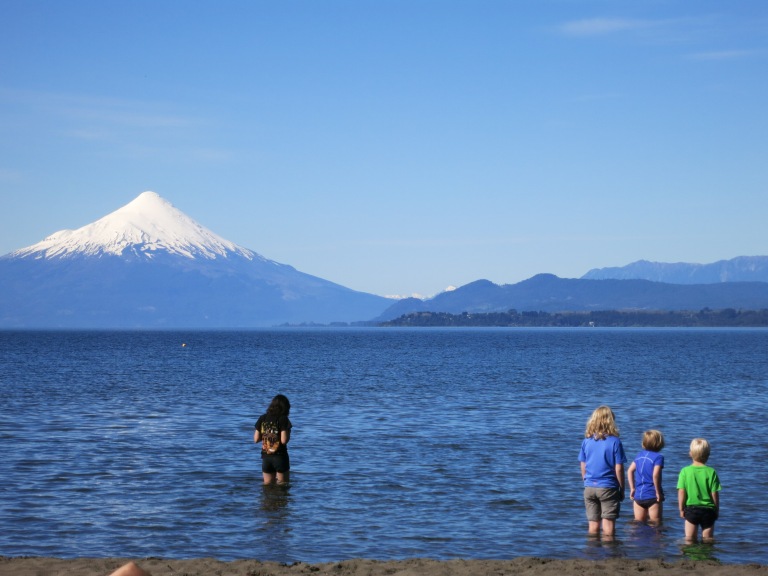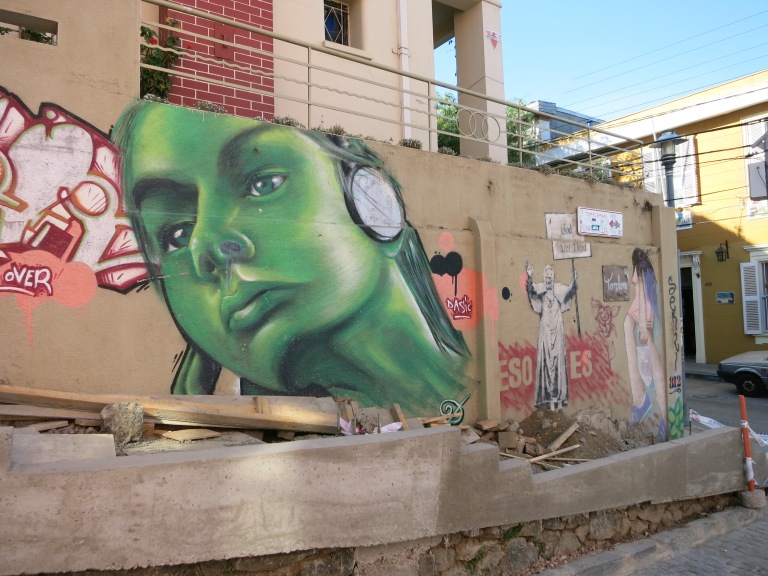Our arrival in Chile heralded a real financial problem; our budgeting had already gone awry as a result of higher than expected inflation and poorly updated guidebook prices. This meant real hardship for the Argentinian people but it also meant that my beautifully colour-coded spreadsheet still looked lovely but bore little resemblance to current reality. However, now in Chile, the problem was far more pressing, the cashpoints wouldn’t give us any money.
A day was spent walking around all the banks at Punta Arenas seeking a solution. Ruaridh, the five year old, seemingly used the time to ponder etymological curiosities. “There are three Chile/lly/illi/s”, he announced before beginning the long process to explain his conclusion; referencing country, temperature and vegetable. For us, there have also been three Chile’s: the Lakes, Santiago and Valparaiso, and the northern desert. The Andes have been a constant reference point to our east.

Having flown over Chilean Patagonia, we spent 4 days in Puerto Varas, a central spot in the Chilean Lake District. The place has a gentile feeling, similar to the English Lake District, slightly sanitised, where the majority of nice people go to admire the view. Others go to hike, bike and kayak. The views from almost anywhere in the town are stunning. Volcanos abound, there are five in the area but it is Osorno that captures the gaze: Ask a child to draw a volcano and they’ll draw something that looks pretty much like its perfect cone. Puerto Varas is nice, I mean really NICE; Chilean families stroll on the volcanic grey sand edging Lago Llanaquihue, enjoying the view and occasionally stopping to point at three little blonde monkeys making a lot of noise on the municipal open-air gyms.
Well-rested, we took an overnight bus to Chile’s capital, Santiago, which, to my surprise, I liked. Like so many colonial cities, it was planned on an easy-to-navigate quadrant design. Elsewhere Polly writes They lived just like you about our visit to the suburbs; we also went to Allende’s tomb; both of these visits were not what our hostel owners expected us to report when they enquired what we had done that day. But we also spent a fair bit of time on the Plaza de Armas, listening to various evangelical ranters, watching the delightful Chilean national dance (La Cueca), keeping hold of our bags; the normal tourist fare. We went to a museum; normally the catalyst for a tantrum brought on by impending boredom (mine not the children) but the gallery of Pre-Columbian Art was shockingly interesting; my attention span at least matched the children’s.

The visit gave rise to interesting discussions with Ishbel and Neamh about Christopher Columbus and the Conquistadores. Trying to present a balanced historical view wasn’t easy and the children spent the next few days exploring the theme. They might blog on it themselves, that’s up to them, but my favourite observations were: Ishbel’s concern about the people already in the ‘New World’; Neamh’s contempt for Columbus as he got himself lost; and Ruaridh didn’t really care whose side he was on as long as he could fight ‘them’.
Months ago, we planned 2 weeks in Valparaiso, a city a couple of hours by bus from Santiago. I had heard of the place and we knew by this point we’d want to stop moving for a bit.
Valpo (as the locals call it), a port city with colourful housing tangled on a number of inter-locking hills (cerros), is the antithesis of Santiago, or at least central Santiago. Nothing is flat, the hills are steep, with houses perching on terraces weather dug into the earth or created by building platforms.

Dirty, grubby, dangerous; brash and slightly impatient, this city has no pretensions. Large cargo ships gather along the coast, queuing to enter the port; addicts congeal around the notorious Plaza Echaurren square looking for a hit or easy tourist prey at night and the early hours of the morning.
Punky fashion flourishes, with the young and not-so-young (but not as old as me) sporting t- shirts with names of bands I’ve seen but didn’t use as a conversation starter as one-upmanship from a smart-arse 50 year old, and a gringo to boot, would be less than attractive.

But in case this all sounds a bit off-putting, please don’t let it have that effect. Valparaiso is also lovely; the historic centre is a UNESCO World Heritage Site. Walking through the city, using ascensors (funiculars) that are a testament to 19th century engineering to climb into the barrios, it is hard not to be charmed as a new vista opens around every corner. Walls and garages are festooned with murals, sadly these are generally plagued by tags: graffiti is an art form but these are no more than the youngsters’ (oh, I hope they are) equivalent of dogs marking their territory by pissing on walls.

Rather than stay in tourist central, we opted to spend our 2 weeks renting a small house in one of the barrios, up Cerro Yungay. Winding around the hills in the 519 micro-bus/roller-coaster meant we got panoramic views of the city. The outlook from our plot was also fantastic. We were the only English speakers around. We were welcome.

Pablo Neruda had a house there (Ishbel and I visited it one rainy Sunday) and wrote Ode to Valparaiso about his beloved city, which begins:
“Valparaiso,
how absurd you are,
what a lunatic,
crazy port.
What a head –
rolling hills,
dishevelled,
you never finished combing your hair…”
Writing about the aftermath of an earthquake, it ends:
“[It] could not
topple you,
because on your southern chest
is tattooed:
the fight,
hope,
solidarity
and happiness
like anchors
that withstand
the waves of the earth.”

After 2 weeks, a 25-hour bus journey delivered us to San Pedro de Atacama, an oasis town in the northern Chilean desert, as spectacular with its Martian-like landscape as Patagonia or the volcanos in the Lake District. We are about to leave Chile for a 3-day trip across the desert to the Salar de Uyuni in Bolivia. We’ve marvelled at the stars and planets in the unpolluted sky, seen the sun set in the Valle de Luna (Valley of the Moon), and picked-up more stray dogs on our strolls.

Chile stretches over 4,300 km from north to south; no surprises that the landscape and climate varies so much but it is universally beautiful and interesting. However, it is Valparaiso, gritty and unpretentious that stirred me. Municipal elections were held yesterday. While the vast majority of Chile moved to the right (a trend in Latin America), Valparaiso did different, electing as their Mayor one of the students who led the 2011 revolts.
Michael MacNeil, 24 October 2016

Lovely Pictures look great and the kids loving it, 25 hour bus journey, no ATM’s, Hope you have a safe journey xx
LikeLike
Wow you have covered a lot of ground in Chile. Valparaiso sounds great and the desert a great contrast. You also seem to be doing a lot of arty stuff – I’m very impressed with your cultural priorities
LikeLike